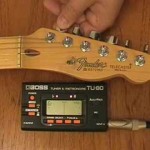It’s always been important to play your instrument ‘in tune’. But what does ‘in tune’ mean?
Instruments like guitars and pianos are tempered (which basically means that you can play in all keys, but slightly and equally out of tune in each; as opposed to playing perfectly in tune in only one key… which is how things were before tempered tuning).
So, playing in tune is a relative thing. It’s not only always approximate to some degree, it’s also subjective to the individual ear. Most instruments have to conform to the tempered piano (or fretted instrument), and the other instrumentalists are usually trying to adjust by getting as close to that tuning as they can.
Even with, say, a string group, which doesn’t have to conform to a piano, our (and the players’ ) ears are used to tempered tuning as the sound of ‘in tune’.
When I first started to play the bass professionally and realized it was crucial to play in tune, the only electronic tuners that were available were encased in boxes the size of toasters, cost many hundreds of dollars, and were affordable only by recording and rehearsal studios that rarely let in scruffy young musicians like me.
So, like most musicians at the time, and almost all who came before us, I had to get my instrument in tune myself. This was actually a great process because, with stringed instruments, you have to learn intonate your guitar.
Intonating in this case means getting the string lengths and heights adjusted correctly, the bridge and the nut in the right place, etc. And you did this all by ear and by yourself, without automated help.
Every once in a while I’d get a session in a professional studio that had one of those big, expensive tuners available. I’d eagerly corner it and check the intonation of my bass… which actually was usually pretty close or even right on.
If you think about it though, in a larger sense this means that at that time everybody tuned their own instruments themselves… which made everyone’s tuning slightly different and individual. Yes, tuning was individual.
This could have horrible-sounding consequences for those who couldn’t or wouldn’t tune up or intonate their instruments.
On the other hand, when you wonder why records sounded different ‘back in the day’. well… this was a big part of it. Back then the band sound was a combination of individual ideas of what was ‘in tune’. When a band had compatible (not identical) conceptions, it could be glorious. When they didn’t, or didn’t care… not so much.
Now we all tune to same notes on our $12 digital tuners. We all play the same ‘A’, the same ‘C’. So pop music is much more in tune now… but it’s all the same tune!
In many ways this has made life much better and easier for musicians – and often for listeners. And overall things are more in tune. We’re dependent on these cheap-to-inexpensive digital tuners and there’s no going back.
But next time you wonder why a current recording doesn’t have the same fullness, the same body… Well, a highly functional tuner now costs about the same as a book (remember them?).
The evolution of the methods and economics of tuning are a much bigger part of why music sounds the way it does now than most people realize.
Thanks for reading! Let me know your thoughts, additions, disagreements in the Comments section below:
And please share on facebook etc. by clicking these tabs –


I remember years ago 25 or so after playing a live set I sometimes felt that we sounded great and then there were other times we ended the set and I would have this feeling that something just wasn’t right that night. It became clear to me what the issue was since the use of the electronic tuner. It was hard tuning with the venue sound system on, I’m surprised we were as close as we were sometimes.
Been there! Thanks, Tom.
Tony
Great post. It’s an huge issue for horn players. I wrote a horn chart once in a Motown style, a lot of triads and fifths, and called in some big band guys I knew to record it with me. Now big band jazz rarely has those kinds of voicings – typically they will have the 3 and 7 of a chord, then maybe 9ths, 11s … all “colour notes” Rarely the root and fifth. Well we spent maybe an hour trying to make that thing sound right, and it somehow never worked. Finally we realised the issue was tuning. We had to blow a completely different way, with a very firm embouchure, and listen really hard to each other. Then it came out well. A lot of rock and folk also uses that kind of scale – if you tune your guitar something like DADGAD better to tune by ear than with the tuner.
Daniel,
It’s good to have the horn perspective here!
Best wishes,
Tony
Very cool article. Thanks for posting.
Thanks for reading and writing, Sherrin!
Best wishes,
TC
The topic of intonation is near and dear to my heart. A few years ago I bought a pedal steel guitar. I could be wrong but I think it enables me to operate in the realm of just intonation (JI) with singers, horns and other instruments capable of making tiny adjustments in their intonation on the fly. Compare a JI fifth interval (702 cents) with an ET fifth (700 cents) for example. You’ll hear the 2 “beats” per second the piano tuner keys in on. For another very interesting computer-based solution to the problem, Google Hermode Tuning and check out some examples on YouTube. The effects of room acoustics? That’s a whole ‘nother topic!